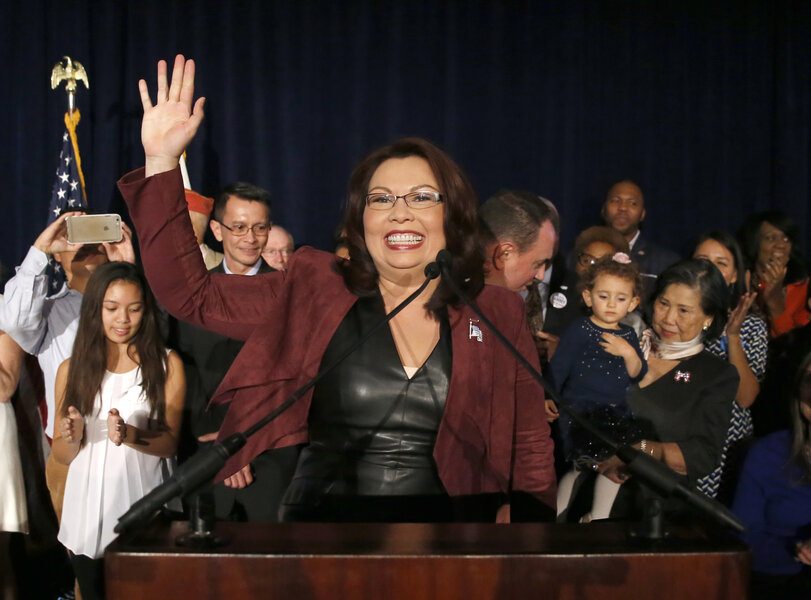Minority women make big strides on Election Day
Loading...
Glass ceilings were shattered Tuesday – just not the highest one.
While Hillary Clinton lost the presidential election, minority women made gains in the US Senate and achieved various firsts in the US House and in state and local elections. The most striking change is coming in the US Senate, which has never had more than one minority female senator at a time.
When the 115th Congress convenes in January, the number of minority female senators will quadruple. The 2016 election marks a significant move toward gender and ethnic parity. And on a practical level, it could improve legislative productivity.
“If a body is more diverse by gender and ethnicity, research has shown that they are better at collaboration and problem-solving,” says Dianne Bystrom, director of Iowa State University’s Carrie Chapman Catt Center for Women and Politics. “Women in the Senate appear to be a close group, they get together socially. Three women of color will bring more perspective to this small group that can seemingly work together across party lines.”
The Senate newcomers are all Democrats. Joining Sen. Mazie Hirono (D) of Hawaii and the first Asian-American woman elected to the Senate, will be Tammy Duckworth of Illinois (the first Thai-American senator), Catherine Cortez Masto of Nevada (the first Latina senator), and Kamala Harris of California (the nation's second African-American female senator).
“The election of the women of color is one of the few bright spots for women in the 2016 campaign,” says Dr. Bystrom. “We didn’t increase the overall number of women [in Congress], but we did increase the women of color.”
Political imbalance
Women constitute 50.8 percent of the overall US population, but only 21 percent of the US Senate and 19 percent of the House of Representatives. And while black, Asian, and Hispanic women make up 18 percent of the population, they only hold 6 percent of the seats in Congress.
Gender and ethnic diversity among elected representatives is important because legislators bring their own life experiences into larger conversations, says Kelly Dittmar, a professor at Rutgers University’s Center for American Women and Politics.
“Right now, we don’t even know how important their perspectives will be. But later on, we will realize how important it was to have had Tammy Duckworth involved in the conversation, or to have had Kamala Harris at the table,” she says.
The Senate already has a tight-knit group of female legislators – dubbed “the sisterhood” – working together on bipartisan legislation.
All 20 female senators partnered together in 2013 to reauthorize the Violence Against Women Act and again in 2015 to back legislation against sex trafficking, as the Monitor’s Linda Feldmann notes in her recent cover story. The best-known example of their teamwork was the 2013 government shutdown, when Republican and Democratic female senators fashioned a compromise deal over dinner.
And the fact that these three women of color were elected to the Senate, the more exclusive chamber of Congress, is noteworthy.
“The Senate has always been known as the old men’s club, which means the old white men’s club,” says Michele Swers, a professor of American government at Georgetown University. The election of these three women begins “changing the narrative of who belongs in political leadership.”
Other glass ceilings
A number of other women also made history Tuesday.
Pramila Jayapal will soon be the first Indian-American woman in the House of Representatives, winning an open seat in Washington State’s Seventh Congressional District.
Stephanie Murphy, the first Vietnamese-American woman elected to Congress, will represent Florida’s Seventh Congressional District, beating incumbent Republican John Mica, who has represented the district since 1993.
Kate Brown of Oregon is the nation’s first openly LGBT governor. She stepped into the governorship in 2015, taking over for resigning Gov. John Kitzhaber. But on Election Day, she won the post on her own.
And Ilhan Omar, a practicing Muslim who wears a hijab, was elected to the Minnesota House of Representatives, America’s first Somali-American legislator.
“It’s not just about making history,” said Cortez Masto in her victory speech Tuesday night. “Don’t you think it is about time that we had diversity in the US Senate? Don’t you think it’s about time that our government mirrors the people we serve every day?”






